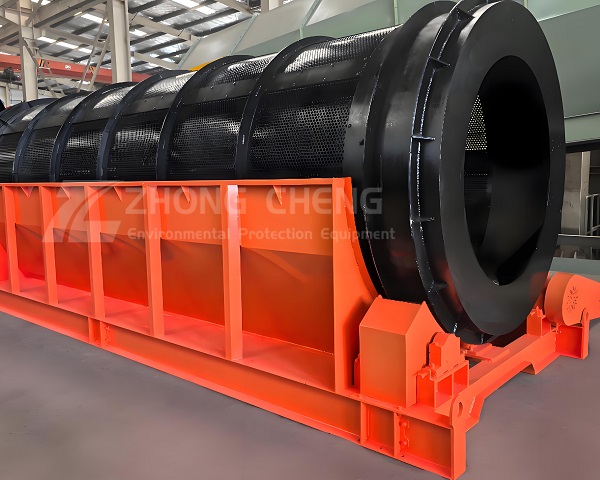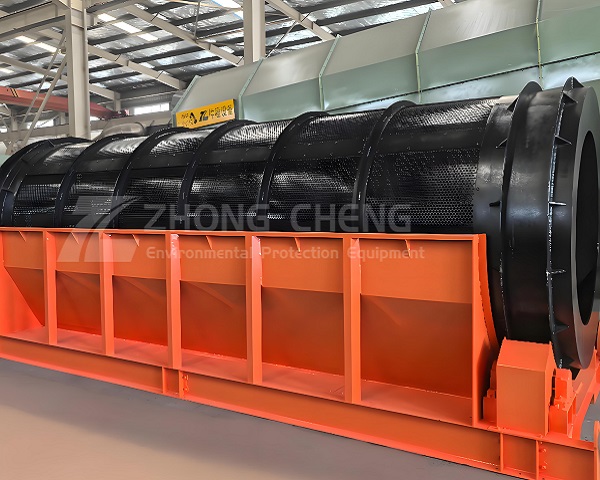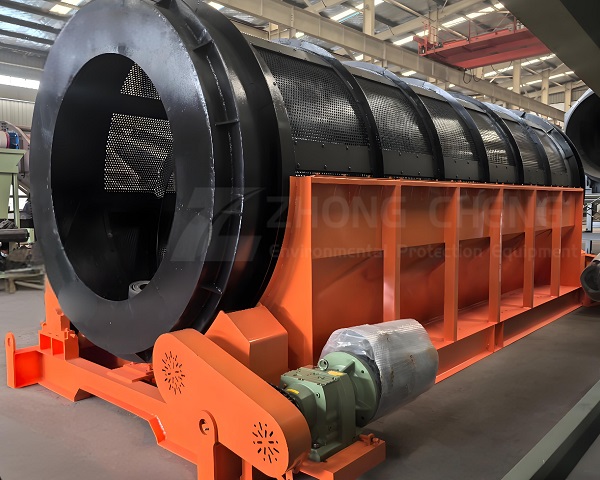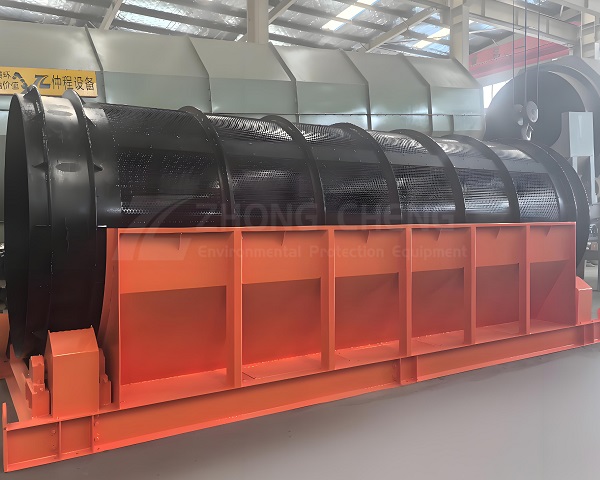A Trommel Screen is a rotary drum screening machine widely used in waste processing, mining, and construction industries. It efficiently separates materials by ......
What is the Waste Trommel Screen
The waste trommel screen is a mechanical sorting equipment widely used in the field of solid waste treatment. It is mainly used for efficient classification and resource pretreatment of mixed garbage. Its core structure consists of a cylindrical screen trommel, a drive device, a support frame and an inlet and outlet. The surface of the screen trommel is designed with screen holes or slits of different apertures according to demand, and the material is separated by particle size through rotation.
Working principle: After the garbage enters the inclined screen trommel through the feed port, the screen trommel rotates at a low speed driven by the motor, and the material is evenly dispersed by gravity, centrifugal force and friction of the screen surface. Smaller particle size materials (such as sand and gravel, humus) fall into the collection device below through the screen holes, and larger lumps (such as plastics, fabrics, bricks) are gradually lifted to the top as the screen trommel rotates, and finally discharged from the end outlet to complete the particle size classification and light material enrichment. Some models are equipped with spraying or crushing devices, which can simultaneously realize the cleaning or pre-crushing functions.
Efficient sorting: strong continuous operation capacity, processing capacity can reach tens to hundreds of cubic meters per hour, suitable for complex waste treatment;
Strong adaptability: the sorting particle size can be adjusted by replacing the screen (usually 5-150mm), compatible with domestic waste, construction waste, stale waste and other types of materials;
Stable operation: low speed design reduces equipment wear, and the sealing structure effectively controls dust and odor diffusion;
Convenient maintenance: modular structure facilitates screen replacement and core component maintenance, reducing operation and maintenance costs.
Domestic waste resource center: separate light impurities in kitchen waste and improve the purity of compost raw materials;
Construction waste treatment plant: remove soil and fine powder from recycled aggregates to improve the quality of recycled building materials;
Industrial solid waste treatment: separate recyclables such as waste plastics and metals to realize the value of circular economy.
Environmental significance: As a key equipment at the front end of waste treatment, the garbage trommel screen reduces the pressure of terminal disposal through precise sorting, improves the resource recovery rate, and helps the construction of "zero-waste city" and the realization of carbon neutrality goals. It is an indispensable technical link in the solid waste treatment industry chain.
Operating principle of Waste Trommel Screen
The waste trommel screen is a mechanical device widely used in solid waste sorting. Its core function is to achieve particle size classification and impurity separation of garbage through rotary screening. Its working principle combines mechanical movement and material characteristics, and has the characteristics of high efficiency and continuous operation. It is widely used in the fields of domestic waste treatment, construction waste recycling and industrial solid waste treatment.
1. Basic structure and movement mode
The main body of the waste trommel screen is a cylindrical metal screen installed at an angle, and spiral guide plates or lifting blades are usually welded inside. When the equipment is running, the motor drives the trommel to rotate at a low speed (generally 5-25 rpm) through a reduction device, and the material is continuously fed from the high-end feed port. The inclination angle of the trommel (usually 5°-15°) is matched with the direction of rotation, so that the material moves slowly to the lower end under the action of gravity, forming a spiral propulsion motion trajectory.
2. Analysis of the screening process
Material dispersion and lifting: When the trommel rotates, the internal blades repeatedly lift and throw the garbage, loosening the agglomerated materials and increasing the contact area between the material and the screen.
Particle size classification: The pore size (such as 50mm, 80mm, etc.) of the screen surface is distributed regularly. Fine particles (such as slag, organic debris) smaller than the pore size directly pass through the sieve holes during the throwing process and fall into the collection hopper below; coarse materials (such as plastics, fabrics, bricks and stones) larger than the pore size cannot pass through the screen and are pushed to the end and discharged as the trommel rotates.
Self-cleaning mechanism: When the trommel rotates continuously, the material that has not passed through the screen keeps rolling to avoid clogging of the screen holes. Some equipment adds a cleaning device (such as a brush or elastic ball) on the inside of the screen to further prevent wet and sticky materials from sticking.
3. Influence of key design parameters
Sieve hole size: directly determines the grading particle size and needs to be adjusted according to the processing target (such as construction waste recycling needs to separate <50mm aggregates).
Speed and inclination: Too fast a speed will result in insufficient material retention time, while too slow a speed will reduce production capacity; too large an inclination may cause material accumulation, which needs to be optimized through experiments.
Screen material: High manganese steel or wear-resistant steel plate are commonly used. Stainless steel can be used for corrosive garbage to extend the life of the equipment.
4. Application advantages and limitations
The advantages of the trommel screen are simple structure, low maintenance cost, and can adapt to complex materials with high moisture content. However, its screening efficiency is greatly affected by the shape of the material (such as fibrous garbage is easy to entangle the screen hole), and the classification accuracy of materials with similar particle sizes is limited. Therefore, in actual projects, it is often used in combination with equipment such as air separators and magnetic separators to form a multi-stage sorting system.
The waste trommel screen achieves the initial particle size control of the garbage through the coordination of mechanical rotation and gravity, providing a key pretreatment step for subsequent resource utilization (such as RDF fuel preparation and recycled aggregate production). With the development of solid waste treatment technology, the trommel screen is evolving towards intelligence (such as variable frequency speed regulation, online monitoring) and modularization to meet more complex garbage classification needs.
Advantages and features of Waste Trommel Screen
As one of the core equipment in the field of solid waste treatment, the waste trommel screen plays an irreplaceable role in the waste pretreatment link with its structural characteristics and process advantages. The following summarizes its core advantages and characteristics from three aspects: technical performance, application scenarios and economy:
1. Technical performance advantages
Efficient screening and continuous operation
The trommel screen adopts a low-speed rotation design (5-25 rpm), combined with an inclination angle (5°-15°), to achieve spiral propulsion screening of materials, with a processing capacity of 20-300 tons/hour (depending on the model).
The continuous feeding and discharging mode avoids the downtime waiting of traditional intermittent equipment and is suitable for large-scale waste treatment production lines.
Wide material adaptability
It can handle wet waste with a moisture content of up to 30% (such as kitchen waste and stale waste), and reduce the risk of screen hole clogging through blade throwing and self-cleaning mechanisms.
It has strong tolerance to hard impurities (such as masonry and glass) in mixed waste, and the screen is made of high manganese steel or wear-resistant steel plate, with a service life of up to 3-5 years.
Flexible grading capability
The sieve hole size can be customized (10-150mm) to meet different particle size grading requirements. For example:
Construction waste recycling: separation of <50mm aggregate for recycled building materials;
Pretreatment of domestic waste: removal of <80mm fine materials to reduce the difficulty of subsequent sorting.
2. Application scenario characteristics
Core equipment for front-end pretreatment
As the "first process" of waste incineration power generation, landfill, and resource utilization production lines, screening reduces the load of subsequent equipment (such as crushers and air separators) and extends the life of equipment.
Typical application case: A city waste incineration plant pre-processed the waste by trommel screen to reduce the moisture content of the waste entering the furnace by 15% and increase the calorific value by 10%.
Modular design adapts to multiple scenarios
It can operate independently or be combined with magnetic separators, air separators and other equipment to form an integrated sorting line to meet different processing needs (such as RDF fuel preparation, metal recycling).
Mobile trommel screens (vehicle-mounted or container-mounted) are suitable for emergency waste treatment or operations in remote areas.
3. Economic and environmental benefits
Low operating cost
The power requirement is only 60%-70% of similar equipment (motor power 10-100kW), and the energy consumption advantage is significant.
Simple maintenance, only regular inspection of screen wear and lubrication system is required, and the spare parts cost is lower than that of complex equipment such as vibrating screens.
Increased resource utilization rate
Through particle size classification, recyclable materials (such as plastics and metals) in waste are separated from inert materials (such as sand and gravel), which increases the resource utilization rate by 20%-30%.
Reduce the amount of terminal landfill, reduce land occupation and leachate treatment costs.
4. Limitations and improvement directions
Bottlenecks in fiber waste treatment: Materials with strong entanglement (such as woven bags and ropes) are prone to clogging of the screen holes, and manual cleaning or pre-crushing is required.
Grading accuracy limitation: The sorting effect of materials with similar particle sizes (such as 40-60mm gravel) is limited, and it is necessary to combine air separation or jig optimization.
Intelligent upgrade space: Some equipment has integrated variable frequency speed regulation and IoT monitoring, but the automation level of the entire industry still needs to be improved.
PS: With the advantages of high efficiency, stability and low cost, the waste trommel screen has become an indispensable screening equipment in the solid waste treatment industry chain. With the tightening of environmental protection policies and the growth of resource demand, its technical upgrade direction will focus on anti-entanglement design, intelligent control system and the application of super wear-resistant materials to cope with more complex waste components and higher treatment standards.
Technical Parameter Table of Waste Trommel Screen
| Parameter category | Parameter name | Unit | Model A (small) | Model B (medium) | Model C (large) | Model D (anti-blocking type) | Model E (mobile) |
|---|---|---|---|---|---|---|---|
| Basic specifications | trommel diameter | mm | 1200 | 1800 | 2500 | 2000 | 1500 (vehicle mounted) |
| trommel length | mm | 3000 | 4500 | 6000 | 5000 | 3500 (foldable) | |
| Screen material | - | 65Mn high manganese steel | Wear-resistant alloy steel | Stainless steel 304 | Polyurethane coated steel mesh | Carbon steel + anti-stick coating | |
| Screening performance | Sieve size | - | 20×20 (square hole) | 50×50 (square hole) | 100×100 (square hole) | 80 (round hole) + anti-winding strip | 30×80 (long round hole) |
| Processing capacity | t/h | 10-20 | 30-50 | 80-120 | 60-90 | 15-25 (vehicle-mounted) | |
| Classification efficiency (≥ target particle size) | % | 85 | 90 | 92 | 88 (anti-blocking optimization) | 80 (mobile loss) | |
| Power and energy consumption | Motor power | kW | 5.5 | 11 | 22 | 15 (variable frequency) | 7.5 (diesel generator) |
| Speed range | r/min | 12-18 | 10-15 | 8-12 | 10-14 (adjustable) | 15 (constant speed) | |
| Energy consumption ratio | kWh/t | 0.3-0.4 | 0.25-0.35 | 0.2-0.3 | 0.28-0.38 | 0.4-0.5 (vehicle mounted) | |
| Structure and material | Tilt adjustment range | ° | 5-12 | 5-15 | 5-18 | 8-15 (anti-blocking type) | Fixed 8° (vehicle mounted) |
| Blade type | - | Spiral lifting type | Angled flow guide type | Combined type (sweeping + lifting) | Anti-entanglement corrugated blade | Lightweight straight blade | |
| Main body material | - | Q235 carbon steel | Q345B low alloy steel | 16Mn high strength steel | Stainless steel 316L (optional) | Lightweight aluminum alloy frame | |
| Operation and maintenance | Noise level | dB(A) | ≤75 | ≤80 | ≤85 | ≤78 (noise reduction design) | ≤82 (vehicle sound insulation) |
| Maintenance cycle | h | 400 | 600 | 800 | 500 (anti-blocking type) | 300 (vehicle-mounted reinforcement) | |
| Lubrication method | - | Centralized lubrication | Automatic oiling | Intelligent lubrication system | Manual + automatic dual mode | Portable manual lubrication | |
| Application scenario | Applicable materials | - | Domestic waste | Construction waste | Stale waste | Kitchen waste/wet materials | Emergency waste disposal |
| Moisture content tolerance range | % | ≤25 | ≤30 | ≤35 | ≤40 (anti-blocking type) | ≤20 (light load on vehicle) | |
| Maximum feed size | mm | ≤150 | ≤250 | ≤400 | ≤300 (anti-blocking optimization) | ≤120 (vehicle height limit) |
If you have any special requirements, we will customize according to your special needs.
Product Picture Display of Waste Trommel Screen
FAQ about Waste Trommel Screen
>Core working principle:
The waste trommel screen uses centrifugal force, gravity and screen friction to classify materials according to particle size by rotating the inclined trommel. Particles smaller than the screen hole leak out, and particles larger than the screen hole are discharged axially. The screen angle and rotation speed jointly determine the screening efficiency.
>Screen hole size selection:
The screen hole size needs to be determined according to the target particle size and material characteristics. Coarse screening selects large apertures (such as 50-100mm), and fine screening selects small apertures (such as 20-30mm). Wet materials are recommended to have oblong holes or anti-entanglement design to avoid blockage.
>Anti-blocking design technology:
The anti-blocking design includes polyurethane coated screens, reduced speed, self-cleaning functions (such as high-pressure spraying) and special-shaped screen holes, which can effectively reduce the entanglement of wet materials or fiber waste and improve screening efficiency.
>Mobile application scenarios:
The mobile trommel screen is suitable for emergency treatment, remote areas, rental markets and multi-site operations. It has the advantages of rapid deployment, flexible power supply and folding design to meet temporary or short-term waste sorting needs.
>Energy consumption optimization methods:
Energy consumption can be reduced through variable frequency motors, lightweight design, intelligent lubrication and screening process optimization. Frequency conversion control can dynamically adjust the speed, reduce no-load loss, and reduce overall energy consumption by 20%-30%.
>Maintenance cycle and key points:
Daily maintenance includes cleaning the screen and checking the lubricating oil level. Regular maintenance requires replacement of grease and tightening bolts. The overhaul cycle involves screen replacement and motor maintenance. Anti-blocking equipment needs to shorten the screen inspection cycle.
>Noise control measures:
Noise can be reduced through measures such as soundproofing covers, shock-absorbing pads, reduced speed and sound barriers. The noise of industrial-grade equipment must be ≤85dB(A), and the noise of mobile equipment must be ≤82dB(A), avoiding high-load operation at night.
>Factors affecting screening efficiency:
Screening efficiency is affected by material moisture content, particle size distribution, screen hole size, trommel inclination, feed uniformity and speed matching. High moisture content or high proportion of bulk materials will significantly reduce efficiency.
>Comparison of advantages and disadvantages with vibrating screen:
The trommel screen has medium screening accuracy but strong anti-blocking ability, low energy consumption and low noise, which is suitable for waste disposal; the vibrating screen has high screening accuracy but is easy to block, has high energy consumption and high noise, which is suitable for mineral sorting.
>Direction of intelligent upgrade:
Intelligent upgrade includes automatic monitoring (such as vibration, infrared sensor), remote control (PLC adjustment parameters), data optimization (recording operating parameters) and extended functions (such as AI visual recognition, IoT connection). In the future, the equipment will have a higher level of automation.


































